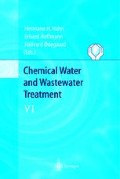Abstract
The particle size distribution (PSD) obtained in effluents treated with two types of coagulants was compared. The objective was to maximize the removal of particles with a size between 0.75 and 1.5 μm, 1.5 and 5.0 μm, and 20 and 80 μm, corresponding to the sizes of fecal coliforms, salmonella and helminth ova, respectively. The coagulant doses tested were 20, 30, 40 and 50 mg/L for both anhydrous aluminum sulfate and PAX·XL-60. The raw wastewater had a PSD between 0.04 and 310 μm, of which 4.4% of the particles were found between 0.75 and 1.5 μm (by volume), 12.7% between 1.6 and 5.0 μm, and 39.4% of the particles were between 20 and 80 μm. It was determined that with 50 mg/L of aluminum sulfate 91% of the particles in the influent were eliminated, whereas with 30 mg/L of PAX XL-60 a 93% removal was achieved. The percentage of remaining particles with diameters between 0.7 and 5.0 μm was 48.9 and 53.8%, respectively, for the two coagulants. Particles between 20 and 80 jum were completely removed by the treatment system in both cases. Under these conditions the effluents had total suspended solids (TSS) concentrations between 39 and 37 mg/L, turbidity between 30 and 39 NTU, and COD between 218 and 233 mg/L, respectively. In terms of the removal of microorganisms, both coagulants removed helminth ova to values below 1 ova/L. Fecal coliforms were reduced from 2.82·108 to 5.45·106 with aluminum sulfate and to 4.85·106 NMP/100 mL with PAX XL-60; salmonella were reduced from 5.43·106 to 9.85·105 and to 4.85·106 NMP/100 mL with the respective coagulants. These levels would require an additional disinfection step to eliminate these organisms to acceptable levels for irrigation. Under the conditions in this study, the change in the PSD made it possible to determine the coagulant dose required to produce suitable water for agricultural reuse by an advanced primary treatment
Access this chapter
Tax calculation will be finalised at checkout
Purchases are for personal use only
Preview
Unable to display preview. Download preview PDF.
References
Official Mexican Standard. NOM-OOl-ECOL/1996. (Establishes the maximum permitted limits of pollutants in the wastewater discharges into water and onto national property) The Official Federal Gazette. January 6, 1997, 67–81
World Health Organization: Health guidelines for the use of wastewater in agriculture and aquaculture, Technical Report Series No. 778. (1989) WHO, Geneva
Biagi, F.: Enfermedades parasitarios. La Prensa Mexicana. México (1990) pp 376
Tay, Z., Aguilera, L., Quiróz, G., Castrejón, V.: Parasitología Médica. Francisco Méndez Cervantes. México, (1991) pp 6–327
Cifuentes, E., Blumenthal, J., Ruiz-Palacios, G., Beneth, S.: Health Impact Evaluation of Wastewater in Mexico. Public Health Revue. 19 (1992) 243–250
Ayres, R.: The Enumeration of Human Intestinal Nematode Ova in Raw and Treated Wastewater. ODA Research Scheme R. 4336. Final report. University of Leeds, Department of Civil Engineering. Leed, U.K. (1989) 639–646
Jawetz, Melmick, Adelberg’s: Microbiología Médica. El Manual Moderno, Mexico. (1995)
Levine, D., Tchobanoglous, G., Takashi, A.: Size Distributions of Particulate Contaminants in Wastewater and Their Impact on Treatability. Wat Res. 25 (8) (1991) pp 911–922
Richert, D. A., Hunter, J.V.: General Nature of Soluble and Particulate Organic in Sewage and Secondary Effluents. Water Research. 5 (7) (1971) pp 421
Thiem, A., Herwing, V., Neis, U.: Particle size analysis for improved sedimentation and filtration in wastewater treatment, Wat. Sci. and Tech. 39(8) (1999) pp 99–106
American Water Woks Association: Committee Coagulation as an Integrated Water Treatment Process. J. Amer. Water Works Assoc. 81 (10) (1990) 72–78
Lawler, F.: Particle Size Distribution in Treatment Processes; Theory and Practice. Water Science and Technology. 36(4) (1997) pp 15–23
Ødegaard, H.: Optimized Particle Separation in the Primary Step of Wastewater Treatment. Wat. Sci. Tech. 37(10) (1998) pp 43–53
Ødegaard, H.: Chemical Floe Formation in Wastewater Treatment - An Introduction. Prog. Wat. Tech. (1979) pp 103–110
Lawler, F., Willkes, D.R.: Flocculation Model Testing Particles Sizes in a Softening Plant. Research & Technology Journal AWWA. 76 (7) (1984) pp 90–97
Cairns, W. L.: Comparing Disinfection by Ultraviolet Light and Chlorination the Implications of Mechanism for Practice. Water Environmental Federation Specialty Conference. May 1993. Whippany, N. Y. (1993) pp 555–565
Jiménez, B., Chávez, A.: Treatment of Mexico City Wastewater for Irrigation Purposes. Environ. Tech., 18 (1997) 721–730
Jiménez, B., Chávez, A., Hernández, C.: Alternative Treatment for Wastewater Destined for Agricultural Use. Wat. Sci. Tech., 40 (4–5) (1999) 355–362
Chávez, A., Jiménez, B.: Distribución del Tamaño de Partícula (DTB) obtenida con la aplicación de PAX XL 60 y Sufato de Aluminio. Compromiso Nacional con el Medio Ambiente, Tomo I, FEMISCA. March 21 to 24, 2000. Morelia, Mich. Mexico (2000) pp 421–431
Standard Methods for the Examination of Water and Wastewater 19th edn. American Public Health Association/American Water Works Association/Water Environment Federation. (1995) Washington D.C. USA
Author information
Authors and Affiliations
Editor information
Editors and Affiliations
Rights and permissions
Copyright information
© 2000 Springer-Verlag Berlin Heidelberg
About this paper
Cite this paper
Mejía, A.C., Cisneros, B.J. (2000). Particle Size Distribution (PSD) Obtained in Effluents from an Advanced Primary Treatment Process Using Different Coagulants. In: Hahn, H.H., Hoffmann, E., Ødegaard, H. (eds) Chemical Water and Wastewater Treatment VI. Springer, Berlin, Heidelberg. https://doi.org/10.1007/978-3-642-59791-6_24
Download citation
DOI: https://doi.org/10.1007/978-3-642-59791-6_24
Publisher Name: Springer, Berlin, Heidelberg
Print ISBN: 978-3-642-64126-8
Online ISBN: 978-3-642-59791-6
eBook Packages: Springer Book Archive

